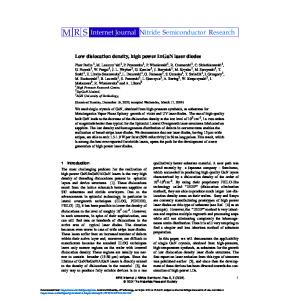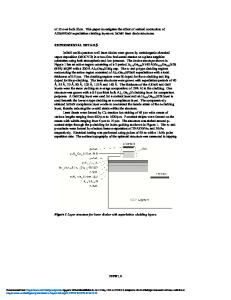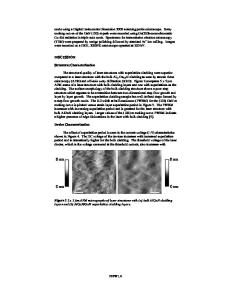Characteristics Of Room Temperature-CW Operated InGaN Multi-Quantum-Well-Structure Laser Diodes
- PDF / 743,182 Bytes
- 12 Pages / 612 x 792 pts (letter) Page_size
- 7 Downloads / 299 Views
Internet Journal of Nitride Semiconductor Research:
Email alerts: Click here Subscriptions: Click here Commercial reprints: Click here Terms of use : Click here
Characteristics Of Room Temperature-CW Operated InGaN Multi-Quantum-Well-Structure Laser Diodes Shuji Nakamura MRS Internet Journal of Nitride Semiconductor Research / Volume 2 / January 1997 DOI: 10.1557/S1092578300001319, Published online: 13 June 2014
Link to this article: http://journals.cambridge.org/abstract_S1092578300001319 How to cite this article: Shuji Nakamura (1997). Characteristics Of Room Temperature-CW Operated InGaN Multi-Quantum-Well-Structure Laser Diodes . MRS Internet Journal of Nitride Semiconductor Research, 2, pp e5 doi:10.1557/S1092578300001319 Request Permissions : Click here
Downloaded from http://journals.cambridge.org/MIJ, IP address: 132.174.255.116 on 10 May 2016
M R S
Internet Journal o f
Nitride S emiconductor Research
Volume 2, Article 5
Characteristics Of Room Temperature-CW Operated InGaN Multi-Quantum-Well-Structure Laser Diodes Shuji Nakamura Nichia Chemical Industries This invited article was received on March 5, 1997 and accepted on March 11, 1997.
Abstract The continuous-wave (CW) operation of InGaN multi-quantum-well-structure laser diodes (LDs) was demonstrated at room temperature (RT) with a lifetime of 35 hours. The threshold current and the voltage of the LDs were 80 mA and 5.5 V, respectively. The threshold current density was 3.6 kA/cm2. When the temperature of the LDs was varied, large mode hopping of the emission wavelength was observed. The carrier lifetime and the threshold carrier density were estimated to be 2-10 ns and 1-2 x 1020/cm3, respectively. From the measurements of gain spectra and an external differential quantum efficiency dependence on the cavity length, the differential gain coefficient, the transparent carrier density, threshold gain and internal loss were estimated to be 5.8x10-17 cm2, 9.3x1019 cm-3, 5200 cm-1 and 43 cm-1, respectively.
1. INTRODUCTION Short-wavelength-emitting devices, such as blue laser diodes (LDs), are currently required for a number of applications, including full-color electroluminescent displays, laser printers, read-write laser sources for high-density information storage on magnetic and optical media, and sources for undersea optical communications. Major developments in wide-gap III-V nitride semiconductors have recently led to the commercial production of high-brightness blue/green light-emitting diodes (LEDs) [1] and to the demonstration of room-temperature (RT) violet laser light emission in InGaN/GaN/AlGaN-based heterostructures under pulsed currents [2] [3] [4] [5] [6] [7] [8] and continuous-wave (CW) operation [9] [10]. These developments are a result of the realization of high-quality crystals of AlGaN and InGaN, and p-type conduction in AlGaN [11] [12] [13] [14]. The recombination of localized excitons has been proposed as an emission mechanism for these InGaN quantum-well-structure LEDs [15] [16] [17]. The radiative recombination of the spont
Data Loading...











